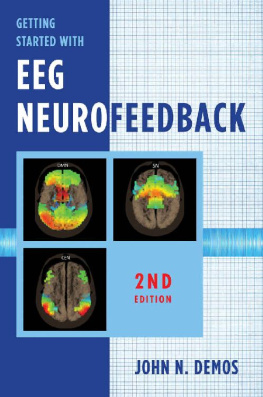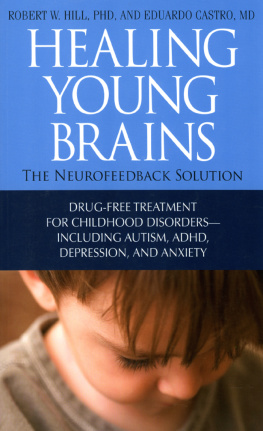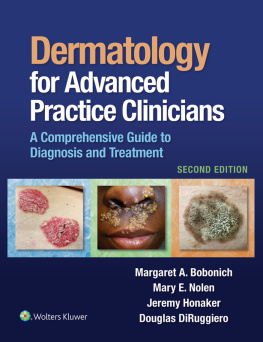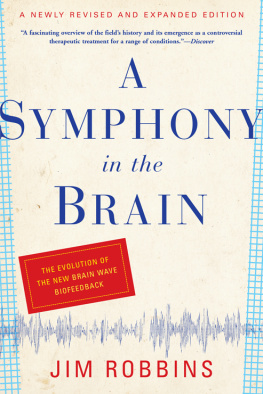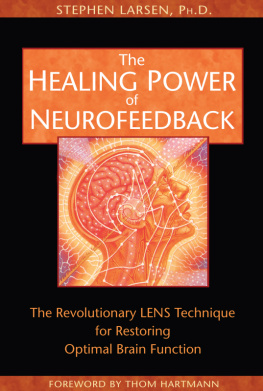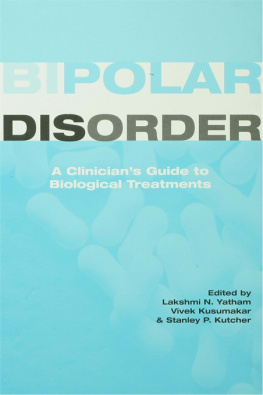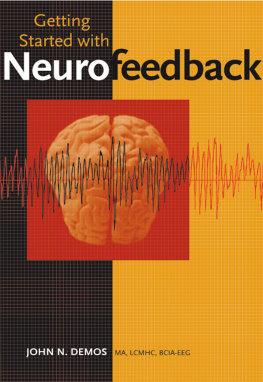Getting Started With
EEG Neurofeedback
SECOND EDITION
John N. Demos

Contents
GETTING STARTED WITH EEG NEUROFEEDBACK, second edition, is a major update to the first edition. The field of neurofeedback has exploded with new modalities such as Z-score training, 3-D standardized low-resolution electromagnetic tomography (sLORETA) imaging, and brain networks such as the default mode network (DMN) and training and brain networks. There is a growing interest in functional and structural neurology. There is a need to understand terms such as diffusion tensor imaging (DTI) and cross-frequency coupling (CFC). More and more licensed practitioners are reading articles published in peer-reviewed journals inside and outside the field of biofeedback. This edition includes well over 150 color images, many of which have been enhanced by the graphic artist Franco Guaglianone. Color images appear throughout the book and are not confined to a color insert.
Since the first edition was published in 2005, my clinic, Neurofeedback of Southern Vermont, LLC, has been accredited by the Biofeedback Certification International Alliance (BCIA) to teach their blueprint of knowledge. Consequently, the second edition reflects key topics from the BCIA curriculum. Additionally, I have been mentoring and consulting with countless practitioners and clinics that want to institute EEG neurofeedback training and become certified by BCIA as neurofeedback clinicians or technicians.
The goal of this book is not to prove that EEG neurofeedback is an effective treatment. The past 12 years have presented me with overwhelming evidence of the power of this modality. The history of biofeedback has been omitted from this edition as other books and many articles have thoroughly explored this topic. The second edition was written to help professionals get started by providing them with an overview of basic assessment methods and training interventions.
Getting started now in 2018 is much easier than it was for me nearly 20 years ago. For example, excellent books have been written, Z-score training has been completed, and automated symptom checklists based on brain maps are available. Newcomers to the field can become successful after a few short months of training, mentoring, and practice. Always keep in mind the importance of keeping up with the ever-expanding field of neurofeedback. There will be books and journals to read and workshops to attend. Becoming an expert requires more knowledge of the brain and the EEG than it did when the first edition was published in 2005. Consequently, the earlier chapters of this book simplify the entire process of doing EEG neurofeedback, whereas the later chapters explore topics that will be needed as one progresses in the field.
There are so many approaches and modalities within the field of neurofeedback and so much we can learn from the many experts in our field. It is my hope that in the future all licensed neurofeedback professionals will respect the work of others even if it is outside their own area of expertise.
FIGURES
Introduction |
Part I |
Part II |
Part III |
Part IV |
Part V |
Part VI |
Appendixes |
CHARTS
Part I |
Part II |
Part IV |
Part V |
Part VI |
AC | alternating current |
ADHD | attention-deficit/hyperactivity disorder |
ANS | autonomic nervous system |
A/T | alpha/theta |
BA | Brodmann area |
BASK | behavior affect sensation and knowledge |
BCIA | Biofeedback Certification International Alliance |
BDI | Beck Depression Inventory |
BORTT | burst of rhythmic temporal theta |
BWE | brain wave entrainment |
CBF | cerebral blood flow |
CC | corpus callosum |
CEN | central executive network |
CFC | cross-frequency coupling |
CNS | central nervous system |
CPS | cycles per second |
CPT | continuous performance test |
Cz | central position |
DAN | dorsal attention network |
DC | direct current |
DMN | default mode network |
DTI | diffusion tensor imaging |
EDF | European Data Format |
EEG | electroencephalograph |
EKG | electrocardiogram |
EMDR | eye movement desensitization and reprocessing |
EOA | electro-ocular |
fMRI | functional magnetic resonance imaging |
GABA | gamma-aminobutyric acid |
HEG | hemoencephalography |
HPA | hypothalamic-pituitary-adrenal |
HRV | heart rate variability |
Hz | hertz |
ILF | infra-low-frequency |
Intl | International |
ISF | infra-slow fluctuation |
ISO | infra-slow oscillation |
LED | light-emitting diode |
LH | left hemisphere |
LORETA | low-resolution electromagnetic tomography |
MRI | magnetic resonance imaging |
mTBI | minor traumatic brain injury |
V | microvolt |
NIR | near infrared |
OCD | obsessive-compulsive disorder |
PDR | posterior dominant rhythm |
pEMF | pulsing electromagnetic field |
PET | positron-emission tomography |
PIR | passive infrared |
PNS | peripheral nervous system |
PTSD | post-traumatic stress disorder |
qEEG | quantitative EEG |
rCBF | regional cerebral blood flow |
RH | right hemisphere |
RIA | relaxation-induced anxiety |
ROI | region of interest |
SD | standard deviation |
sEMG | surface electromyography |
SMR | sensorimotor rhythm |
SN | salience network |
SPECT | single-positron-emission computerized tomography |
SSRI |
Next page
